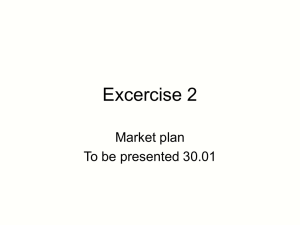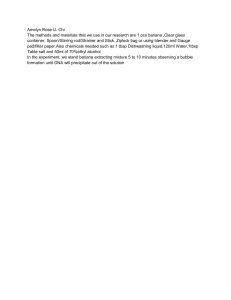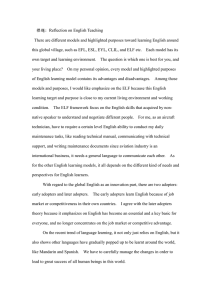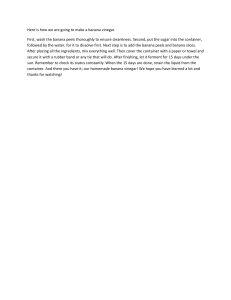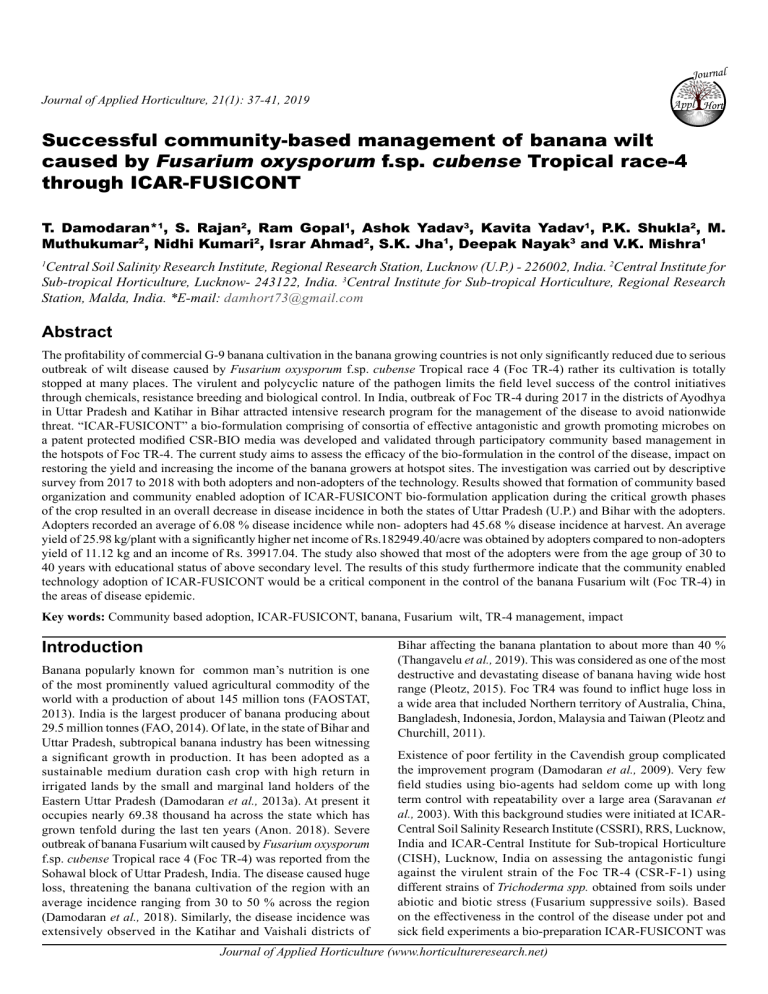
Journal Journal of Applied Horticulture, 21(1): 37-41, 2019 Appl Successful community-based management of banana wilt caused by Fusarium oxysporum f.sp. cubense Tropical race-4 through ICAR-FUSICONT T. Damodaran*1, S. Rajan2, Ram Gopal1, Ashok Yadav3, Kavita Yadav1, P.K. Shukla2, M. Muthukumar2, Nidhi Kumari2, Israr Ahmad2, S.K. Jha1, Deepak Nayak3 and V.K. Mishra1 Central Soil Salinity Research Institute, Regional Research Station, Lucknow (U.P.) - 226002, India. 2Central Institute for Sub-tropical Horticulture, Lucknow- 243122, India. 3Central Institute for Sub-tropical Horticulture, Regional Research Station, Malda, India. *E-mail: damhort73@gmail.com 1 Abstract The profitability of commercial G-9 banana cultivation in the banana growing countries is not only significantly reduced due to serious outbreak of wilt disease caused by Fusarium oxysporum f.sp. cubense Tropical race 4 (Foc TR-4) rather its cultivation is totally stopped at many places. The virulent and polycyclic nature of the pathogen limits the field level success of the control initiatives through chemicals, resistance breeding and biological control. In India, outbreak of Foc TR-4 during 2017 in the districts of Ayodhya in Uttar Pradesh and Katihar in Bihar attracted intensive research program for the management of the disease to avoid nationwide threat. “ICAR-FUSICONT” a bio-formulation comprising of consortia of effective antagonistic and growth promoting microbes on a patent protected modified CSR-BIO media was developed and validated through participatory community based management in the hotspots of Foc TR-4. The current study aims to assess the efficacy of the bio-formulation in the control of the disease, impact on restoring the yield and increasing the income of the banana growers at hotspot sites. The investigation was carried out by descriptive survey from 2017 to 2018 with both adopters and non-adopters of the technology. Results showed that formation of community based organization and community enabled adoption of ICAR-FUSICONT bio-formulation application during the critical growth phases of the crop resulted in an overall decrease in disease incidence in both the states of Uttar Pradesh (U.P.) and Bihar with the adopters. Adopters recorded an average of 6.08 % disease incidence while non- adopters had 45.68 % disease incidence at harvest. An average yield of 25.98 kg/plant with a significantly higher net income of Rs.182949.40/acre was obtained by adopters compared to non-adopters yield of 11.12 kg and an income of Rs. 39917.04. The study also showed that most of the adopters were from the age group of 30 to 40 years with educational status of above secondary level. The results of this study furthermore indicate that the community enabled technology adoption of ICAR-FUSICONT would be a critical component in the control of the banana Fusarium wilt (Foc TR-4) in the areas of disease epidemic. Key words: Community based adoption, ICAR-FUSICONT, banana, Fusarium wilt, TR-4 management, impact Introduction Banana popularly known for common man’s nutrition is one of the most prominently valued agricultural commodity of the world with a production of about 145 million tons (FAOSTAT, 2013). India is the largest producer of banana producing about 29.5 million tonnes (FAO, 2014). Of late, in the state of Bihar and Uttar Pradesh, subtropical banana industry has been witnessing a significant growth in production. It has been adopted as a sustainable medium duration cash crop with high return in irrigated lands by the small and marginal land holders of the Eastern Uttar Pradesh (Damodaran et al., 2013a). At present it occupies nearly 69.38 thousand ha across the state which has grown tenfold during the last ten years (Anon. 2018). Severe outbreak of banana Fusarium wilt caused by Fusarium oxysporum f.sp. cubense Tropical race 4 (Foc TR-4) was reported from the Sohawal block of Uttar Pradesh, India. The disease caused huge loss, threatening the banana cultivation of the region with an average incidence ranging from 30 to 50 % across the region (Damodaran et al., 2018). Similarly, the disease incidence was extensively observed in the Katihar and Vaishali districts of Bihar affecting the banana plantation to about more than 40 % (Thangavelu et al., 2019). This was considered as one of the most destructive and devastating disease of banana having wide host range (Pleotz, 2015). Foc TR4 was found to inflict huge loss in a wide area that included Northern territory of Australia, China, Bangladesh, Indonesia, Jordon, Malaysia and Taiwan (Pleotz and Churchill, 2011). Existence of poor fertility in the Cavendish group complicated the improvement program (Damodaran et al., 2009). Very few field studies using bio-agents had seldom come up with long term control with repeatability over a large area (Saravanan et al., 2003). With this background studies were initiated at ICARCentral Soil Salinity Research Institute (CSSRI), RRS, Lucknow, India and ICAR-Central Institute for Sub-tropical Horticulture (CISH), Lucknow, India on assessing the antagonistic fungi against the virulent strain of the Foc TR-4 (CSR-F-1) using different strains of Trichoderma spp. obtained from soils under abiotic and biotic stress (Fusarium suppressive soils). Based on the effectiveness in the control of the disease under pot and sick field experiments a bio-preparation ICAR-FUSICONT was Journal of Applied Horticulture (www.horticultureresearch.net) 38 Community-based management of banana wilt (Foc TR-4 ) through ICAR-FUSICONT developed using antagonistic, growth promoting strains CSR-T-3 of Trichoderma reesei (MH997668.1) (Damodaran et al., 2019) and CSR-A-11 of Lysnibacillus fusiformis (KU745624.1) (Damodaran et al., 2018) in a consortia mode, cultured on an IPR protected modified CSR-BIO media. The technology was intervened on a pre-commercialization evaluation mode in the hotspots over an area of 85 acres in the Ayodhya district of Uttar Pradesh and over 60 acres in Katihar district of Bihar. The current study was formulated to assess the impact of community mobilization and adoption of the bio-formulation ICAR-FUSICONT in the control of the disease and consequent effect on yield, total expenditure and total net income of the various adopters and non-adopter’s community. Materials and methods Study area: The study was carried out as Inter-institutional research project of Indian Council of Agricultural Research at two locations Maksoomganj and Mangalsi from Sohawal block in the Ayodhya district of Uttar Pradesh (U.P.), India and two locations Dighri and Kursela from the Katihar district in Bihar, India. The selection of study area was based on the severity of the disease incidence. Efforts like use of chemical fungicides and bioagents involving different strains of Trichoderma, Pseudomonas etc. attempted prior to adoption of the ICAR-FUSICONT technology failed to control the disease in the selected districts ending in severe crop loss in the study area. Survey data suggested continuous failure of the crop due to disease since 2014 in the study area. The technological intervention using ICAR-FUSICONT was made through formation of community groups of the cultivators from the affected areas. The community groups were sensitized and were made to adopt the technology with uniform application and control protocol. The protocols consist of nursery drenching of secondary hardened tissue culture plantlets with one percent ICAR-FUSICONT solution before planting in main field. Further, soil drenching with two percent ICAR-FUSICONT mixture was carried out at the critical stages of the crop growth. The disease incidence percentage was assessed on the morphological symptoms and non-destructive corm discoloration symptom. Pathogen confirmation was undertaken using PCR analysis of the DNA sampled from symptomatic plants using specific primer of Foc TR-4 with amplification at 463 bp (Dita et al., 2010). The fields exhibiting the initial pathogen inocula ranging from 4 x 104 to 6 x 105 was considered for the impact study with adopters and non-adopters. The disease incidence percentage was calculated using the formula Number of infected plants Disease incidence (%)= x 100 Total number of plants Data design: The data used in this study were collected in face-to-face interviews with adopters and non- adopters of ICAR-FUSICONT technology from the selected villages at two locations, Uttar Pradesh and Bihar, respectively. The data was collected during 2017-18 and 2018-19. A structured questionnaire was designed and used in the collection of data from the respondents. Data were collected from 30 adopters and 30 non-adopters of the technology in G-9 banana var. The respondents were selected based on the similar disease incidence level at initial stage of the technological (ICAR-FUSICONT) intervention, socio-economic conditions and land holding. The survey instruments consisted of questions where respondents were asked information about production, perceived yield losses due to the incidence of banana wilt disease, expenditure incurred in production (input cost, irrigation cost, labour cost including family labour, land lease cost if not cultivated and depreciation cost of farm implements and farm implements rental and repair cost), use of pesticide / fungicide and gross income obtained at the end of the growing season. The gross income was the farm gate prices by selling the produce from individuals during the season. The total net income of the household was calculated by removing the total expenditure cost from the total gross income obtained by the sale of the produce. The data regarding the land holding status, age and education of the adopters and non-adopters were also collected to assess the social status of the surveyed population. Survey was restricted to adopters and non-adopters of the community with similar disease incidence, land fertility status and market. Frequencies, means and standard deviation and independent ‘t’ test were used for testing the significance at P = 0.01 between adopters and non-adopters. All the analysis was carried out using SAS 9.2 software. Result and discussion Disease incidence percentage (DIP): The findings of the survey data analyzed using Independent ‘t’ test depicted the existence of significant differences between adopters and non-adopters with respect to disease incidence percentage (DIP) in both the states at all locations (Table 1). The DIP among the adopters was observed to be 2.28 % in U.P. and 10.85 % in Bihar at harvest, while the non-adopters recorded a final DIP of 45.40 % in U.P and 46.04 % in Bihar. Similar trend was also found in the pooled analysis of data over all locations. The adopters (6.08 %) had significantly lower disease incidence than the non-adopters (45.68 %). Studies conducted earlier, using combined application of fungicide with Psuedomonas florescence strain PF1 showed reduction of disease incidence up to 64 % in the green house and 75 % in field conditions for race 1 of banana Fusarium wilt (Akila et al., 2011). In China, application of bio-fertilizer “BIO” resulted in 20 % disease incidence compared to 38 % in control (Shen et al., 2013). Based on our results and the work of others under control and field conditions, it can be observed that application of the ICAR-FUSICONT showed significant reduction of the disease in the adopters. Yield: Significant differences in the yield of the plant were observed between adopters and non-adopters of the technology in both the states Table 1. Impact of ICAR-FUSICONT in the control of Fusarium (TR-4) wilt disease of banana in Bihar and Uttar Pradesh (n=30) Location Community/ Percent Yield / Expenditure/ Net income/ Adoption disease plant acre acre incidence Bihar Adopters 10.85 27.38 125487.63 195885.48 (±7.74) (±3.22) (±20450.65) (±88196.00) Non46.04 11.25 85900.14 47920.16 adopters (±18.13) (±1.51) (±8752.79) (±19340.55) Uttar Adopters Pradesh Nonadopters 2.28 (±0.49) 45.40 (±20.23) 24.88 (±2.99) 11.03 (±2.52) 126565.48 172600.61 (±23655.00) (±62224.50) 98208.04 33514.54 (±10587.10) (±13423.40) Values in the parentheses indicate the standard deviation of the replicates with the mean Journal of Applied Horticulture (www.horticultureresearch.net) Community-based management of banana wilt (Foc TR-4 ) through ICAR-FUSICONT 39 pooled analysis of the adopters and non-adopters showed an expenditure of Rs.126086.40 / acre for successful cultivation of the crop while the non-adopters incurred lower expenditure of Rs.92737.86 due to the reduction in the input cost for the plants that had reached mortality due to the disease much before harvest. Fig. 1. Pattern of yield per plant with respect to ICAR-FUSICONT adoption. of Uttar Pradesh and Bihar under all locations. The adopters from Uttar Pradesh obtained an average yield of 24.88 kg/plant while the non-adopters obtained 11.03 kg/plant (Table 1). Similarly, the adopters in Bihar (Table 1) obtained significant higher average yield (27.38 kg/ plant) than the non-adopters (11.25 kg/plant). The pooled analysis (Table 2) also showed that the adopters managed an average yield of 25.98 kg/plant while the non-adopters could get a mean yield of 11.12 kg/plant due to higher disease incidence. The average yield obtained by the adopters was significantly higher than the non-adopters (Fig. 1). The reduction in the yield of the non-adopters was due to death of diseased plants or poor growth. Potential antagonists application in combination with organic substitutes in China under in vivo conditions have shown better control of Foc TR-4 of banana, thereby restoring the yield potential of the plant (Xue, et al., 2015 and Shen et al., 2015). Studies on management of Fusarium wilt race 1 in India observed that in vitro co-culturing of banana tissue culture plantlets with Pseudomonas fluorescens Pf1, Bacillus subtilis EPB 10 have proved to increase the bunch yield and fruit quality due to the control of the disease (Kavino et al., 2016). Field inoculation with endophyte and rhizobacteria strain led to the control of banana Fusarium wilt caused by F. oxysporum f.sp. cubense race 1 to about 78 % than the untreated control with higher bunch weight (Kavino and Manoranjitham, 2018). Expenditure and net income: In present study, significant variations were found to exist between the adopters and nonadopters of both Uttar Pradesh and Bihar with regard to the expenditure incurred in production and net income obtained from the on-farm sale of the produce. The average expenditure incurred in the production in one acre was Rs.125487.63 and Rs.126565.48 for adopters in Bihar and Uttar Pradesh respectively (Table 1). Non-adopters incurred an average expenditure of Rs.85900.14 and Rs.98208.04 in Bihar and Uttar Pradesh, respectively. The Table 2. Pooled impact of the ICAR-FUSICONT in the control of the Fusarium (TR-4) wilt disease of banana at the hotspots (n=60) Community Percent Yield / Expenditure/ Net disease plant acre income/ incidence acre Adopters 6.08 25.98 126086.40 182949.40 (7.74) (3.63) (17321.18) (77450) Non45.68 11.12 92737.861 39917.038 adopters (18.13) (1.33) (10687.21) (13998.22) ‘t’ value -12.04* 23.05* 9.86* 9.63* Values in the parentheses indicate the standard deviation of the replicates with the mean The average net income of the adopters was significantly higher (Rs.195885.48 and Rs.172600.61 in Bihar and Uttar Pradesh respectively) than the average net income of the non-adopters (Rs.47920.16 and Rs.33514.54 in Bihar and Uttar Pradesh, respectively). Pooled data analysis of adopters in hotspots also revealed higher net income in adopters due to lower disease incidence percentage because of the application of the bioformulation ICAR-FUSICONT regularly according to the specified protocol. The average net income obtained by the Fig. 2. Pattern of net income with respect to ICAR-FUSICONT adoption. Table 3. Correlation co-efficient between disease incidence percentage, yield per plant, total income, total expenditure and net income for one acre Percent Yield / Total Expenditure/ Net disease plant income/ acre income/ incidence acre acre Disease incidence (%) 1.00 Yield / plant -0.80** 1.00 Total income / acre -0.87** 0.87** Expenditure/ acre -0.78** 0.78** 0.87** 1.00 Net income/acre -0.82** 0.90** 0.98** 0.82** 1.00 1.00 **Correlation is significant at the .01 level (2-tailed) (n=30). adopters was significantly higher than the non-adopters (Fig. 2). Significant negative correlation was found to exist between the disease incidence percentage and yield / plant, expenditure / acre and net income / acre (Table 3) indicating the efficacy of the bioformulation in the control of the disease. Survey results suggest that the higher disease incidence percentage resulted in complete mortality of the affected plants at the later stage of the crop where sufficient expenditure has been incurred to the plantation from planting till mortality. This attribute to the significant lower net income in the highly infected plantations of the non-adopters compared to adopters. Studies by earlier workers showed that biological control is considered to effectively reduce the disease development and the yield loss of crops thereby increasing the farm income (Nega, 2014). In addition, many of these improved bio-formulations under biological control are knowledge Journal of Applied Horticulture (www.horticultureresearch.net) 40 Community-based management of banana wilt (Foc TR-4 ) through ICAR-FUSICONT Outbreak of banana Fusarium wilt caused by Foc TR-4 in Bihar Table 4. Social status of the adopters of ICAR-FUSICONT technology in the states of Uttar Pradesh and Bihar in India Characteristics group Adopters in Uttar Adopters in Bihar Pradesh (%) (%) Age 20-30 years 36.67 20.00 30-40 years 46.67 60.00 40-50 years 13.33 20.00 50-60 years 3.33 0.00 < 1 ha 86.67 23.33 > 1 ha 13.33 76.67 Primary level education 26.67 40.00 Secondary level and above 73.33 60.00 Land holding Educational status intensive with mixed positive and negative results than the existing chemical control measures. Simplified cost effective with intensive scientific validation tend to increase the farm adoption percentage along with increase in farm income (Pingali et al., 1997). Bio-formulations with consortia of effective microbes on a dynamic media contributes for enhancing the growth and inducing tolerance to soil borne diseases in banana and tomato (Damodaran et al., 2013b) Assessment of the social status of the adopters and non-adopters (Table 4) with regard to age, land holding and educational status revealed that about 46.67 and 60.00 % adopters were in the age group of 30 to 40 years in U.P. and Bihar, respectively. Average land holding analysis showed that about 86.67 % of adopters in U. P. were having less than one ha while in Bihar about 76.67 % of adopters were with the land holding of more than one ha. We also observed that about 60 to 73.3% of the adopters were having education status of secondary level and above. Our study on social status showed that most of the farmers in the affected region of U.P. where small to marginal while in Bihar most of the banana cultivators of the disease affected zone were small to large farmers. Farm size was considered as one of the significant factor influencing the adoption of organic farming technologies (Adebayo et al., 2013). Education status played a major role in adoption of the technology. Youths in the The same field after implementaion of ICAR-FUSICONT technology age group of 30 to 40 were more interested in the adoption of the technology as they felt the need to control the disease and restore the banana cultivation due to the remunerative returns from the commercial banana farming. Earlier studies conducted with the bio-formulation CSR-BIO for enabling cost effective banana cultivation in the Indo-Gangetic plains also suggested the adoption of new technologies by the youths with secondary educational background (Damodaran et al., 2013a). Studies on the age group of the adopters and non-adopters of the biological control technology showed insignificant difference between the age groups of the adopters and non-adopters as both felt the need to control the disease (Niyaki et al., 2010). In our study, it was observed that the growers in the age group of more than 50 years and who were having educational status of primary level or below were reluctant to adopt the new technology. The age and education level would have been the possible reason for reluctant adoption of the biological control technology. ICAR-FUSICONT technology intervention through participatory community adoption approach reduced the incidence of the disease thereby enabling the restoration of high yield that attributed to the significantly higher income obtained by the adopters than non-adopters. The adopters within the age group of 30 to 40 years showed more interest in the technology due to the higher literacy level and need for improving livelihood through G-9 banana cultivation. References Adebayo, S. and O. I. Oladele, 2013. Vegetable farmers’ attitude towards organic agriculture practices in South Western Nigeria. Journal of Food, Agriculture and Environment, 11: 548-552. Akila R., L. Rajendran, S. Harish, K. Saveetha, T. Raguchander and R. Samiyappan, 2011. Combined application of botanical formulations and biocontrol agents for the management of Fusarium oxysporum f. sp. cubense (Foc) causing Fusarium wilt in banana. Biol. Control, 57: 175-183. Anonymous, 2018. Horticulture statistics at a glance. Published by Horticultural Statistics Division, Ministry of Agriculture and Farmer’s welfare. India, pp.174. Damodaran, T., N. Kumar and M. Kavino, 2009. Breeding and evaluation of Musa hybrids resistant to Fusarium oxysporum f. sp. cubense race 1. Fruits, 64: 3-12. Journal of Applied Horticulture (www.horticultureresearch.net) Community-based management of banana wilt (Foc TR-4 ) through ICAR-FUSICONT Damodaran, T., R.B. Rai, S.K. Jha, D.K. Sharma, V.K. Mishra, K. Dhama, A.K. Singh and V. Sah, 2013a. Impact of social factors in adoption of CSR BIO - A cost effectve, ecofriendly bio-growth enhancer for sustainable crop production. South Asian J. Exp. Bio., 3(4): 158-165. Damodaran, T., R.B. Rai, S.K. Jha, K. Dhama, V.K. Mishra, D.K. Sharma, A.K. Singh and Himanshu Dixit, 2013b. Impact of CSR-BIO - An Eco-Friendly Bio-Growth Enhancer on increasing the profitability of horticultural crops to small and marginal land holders. Int. J. Curr. Res., 5(09): 2682-2685. Damodaran T., S. Rajan, V.K. Mishra, S.K. Jha, I. Ahmad and R. Gopal, 2018. First report of Fusarium wilt in banana caused by Fusarium oxysporum f. sp. cubense Tropical race 4 in India. Plant Dis., 103(5): 1022-1022. doi: 10.1094/PDIS-07-18-1263-PDN. Damodaran, T., S. Rajan, V.K. Mishra, S.K. Jha, R. Gopal, and P.C. Sharma, 2019. CSR-FUSICONT-An Innovative Technology for the Control of Fusarium Wilt (TR-4) of Banana var. Grand Naine in Normal and Reclaimed Sodic Soils. A Golden Jubilee International Salinity Conference: Resilient Agriculture in Saline Environment under Changing Climate: Challenges and Opportunities: 153. Damodaran, T., V.K. Mishra, S.K. Jha, U. Gupta, R. Gopal, 2018a. Identification of Rhizosphere Bacterial Diversity with Promising Salt Tolerance, PGP Traits and Their Exploitation for Seed Germination Enhancement in Sodic Soil. Agr. Res. 8(1):36-43. Dita, M.A., C. Waalwijk, I.W. Buddenhagen, M.T. Souza Jr and G.H.J. Kema, 2010. A molecular diagnostic for tropical race 4 of the banana fusarium wilt pathogen. Plant Patho., 59: 348-357. FAO, 2014. FAO Stat. http://www.fao.org/economic/est/statistical-data/ en/). FAOSTAT, 2013. http://faostat.fao.org/. Kavino, M. and S.K. Manoranjitham, 2018. In vitro bacterization of banana (Musa spp.) with native endophytic and rhizospheric bacterial isolates: Novel ways to combat Fusarium wilt. Eur. J. Plant Pathol., 151(2): 371-387. Kavino, M., S.K. Manoranjitham, N. Kumarand and R.M. Vijayakumar, 2016. “Plant growth stimulation and biocontrol of Fusarium wilt (Fusarium oxysporum f. sp. cubense) by co-inoculation of banana (Musa spp.) plantlets with PGPR and endophytes,” in Proceedings of the ‘4th Asian PGPR – Recent Trends in PGPR Research for Sustainable Crop Productivity’ (Hanoi: Asian PGPR Society) 77–83. 41 Nega, A., 2014. Review on Concepts in Biological Control of Plant Pathogens. J. Biology, Agri. Healthcare, 4 (27): 33-54. Niyaki, S.A.N., R. Radjabi and S. Allahyari, 2010. Social factors critical for adoption of biological control agents Trichogramma Spp. egg parasitoid of rice stem borer chilo suppressalis in north of Iran. American- Eurasian J. Agr. Environ. Sci., 9(2): 133-139. Pingali, P.L., M. Hossain and R.V. Gerpacio, 1997. Asian Rice Bowls: The Returning Crisis. Wallingford, UK: CAN International. Ploetz, R.C., 2015. Fusarium wilt of banana. Phytopathol., 105(12): 1512–1521. Ploetz, R.C. and A.C.L. Churchill, 2011. Fusarium wilt: the banana disease that refuses to go away. Acta. Hort., 897: 519-526 Saravanan, T., M. Muthusamy and T. Marimuthu, 2003. Development of integrated approach to manage the Fusariam wilt of banana. Crop Protection, 22, 1117-1123. Shen, Z., Y. Ruan, C. Xue., S. Zhang, R. Li and Q. Shen, 2015. Rhizosphere microbial community manipulated by 2 years of consecutive biofertilizer application associated with banana Fusarium wilt disease suppression. Biol. Fertil. Soils, 51: 553-562. Shen. Z., S. Zhong, Y. Wang, B. Wang, X. Mei, R. Li, Y. Ruan and Q. Shen, 2013. Induced soil microbial suppression of banana Fusarium wilt disease using compost and biofertilizers to improve yield and quality nutrition and fertilization in low-middle reaches of the Yangtze river. EJSOBI, 57: 1-8. Thangavelu. R., D. Mostert, M. Gopi, P. Ganga Devi, B. Padmanaban, A.B. Molina, and A. Viljoen, 2019. First detection of Fusarium oxysporum f. sp. cubense tropical race 4 (TR4) on Cavendish banana in India. Eur. J. Plant Pathol., doi.org/10.1007/s10658-019-01701-6. Xue, C., C.R. Penton, Z. Shen, R. Zhang, Q. Huang, R. Li, Y. Ruan and Q. Shen, 2015. Manipulating the banana rhizosphere microbiome for biological control of Panama disease. Sci. Rep., 5: 11124. Received: March, 2019; Revised: March, 2019; Accepted: March, 2019 Journal of Applied Horticulture (www.horticultureresearch.net)
